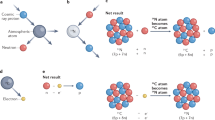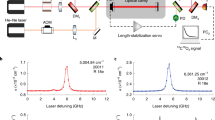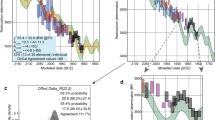Abstract
RECENT evidence suggests that the racemisation reaction of aspartic acid can be used to date fossil bones1–3 (for a general review see ref. 4). At 20 °C the half life for aspartic acid racemisation is about 15,000 yr. Because the aspartic acid reaction has a longer half life than radiocarbon it can be used to date bones which are beyond the 14C dating limit (that is >40,000 yr old). Also only a few grams of bone are required for a DL-aspartic acid determination so bones which are available in insufficient quantities for radiocarbon dating can be dated from the extent of aspartic acid racemisation.
This is a preview of subscription content, access via your institution
Access options
Subscribe to this journal
Receive 51 print issues and online access
$199.00 per year
only $3.90 per issue
Buy this article
- Purchase on Springer Link
- Instant access to full article PDF
Prices may be subject to local taxes which are calculated during checkout
Similar content being viewed by others
References
Bada, J. L., and Protsch, R., Proc. natn. Acad. Sci. U.S.A., 70, 1331–1334 (1973).
Bada, J. L., Schroeder, R. A., Protsch, R., and Berger, R., Proc. natn. Acad. Sci. U.S.A., 71, 914–917 (1974).
Bada, J. L., Schroeder, R. A., and Carter, G. F., Science, 184, 791–793 (1974).
Bada, J. L., and Schroeder, R. A., Naturwissenschaften, 62, 71–79 (1975).
Klein, R. G., Quaternary Res., 2, 135–142 (1972).
Wymer, J. J., and Singer, R., in Man, Settlement and Urbanism (edit. by Ucko, P. J., Tringham, R., and Dimbleby, G. W.), 207–210 (Duckworth, London, 1972).
Vogel, J. C., and Beaumont, P., Nature, 237, 50–51 (1972).
Klein, R. G., Wld Archaeol., 5, 249–284 (1974).
Ku, T. L., Kimmel, M. A., Easton, W. H., and O'Neil, T. J., Science, 183, 959–962 (1974).
Veeh, H. H., J. geophys. Res., 71, 3379–3386 (1966).
Ku, T. L., and Kern, J. P., Bull. geol. Soc. Am., 85, 1713–1716 (1974).
Broecker, W. S., et al., Science, 159, 297–300 (1968).
Shackleton, N. J., and Opdyke, N. D., Quaternary Res., 3, 39–55 (1973).
Chappell, J., Bull. geol. Soc. Am., 85, 553–570 (1974).
Bloom, A. L., Broecker, W. S., Chappell, J. M. A., Matthews, R. K., and Mesolella, K. J., Quaternary Res., 4, 185–205 (1974).
Steinen, R. P., Harrison, R. S., and Matthews, R. K., Bull. geol. Soc. Am., 84, 63–70 (1973).
Author information
Authors and Affiliations
Rights and permissions
About this article
Cite this article
BADA, J., DEEMS, L. Accuracy of dates beyond the 14C dating limit using the aspartic acid racemisation reaction. Nature 255, 218–219 (1975). https://doi.org/10.1038/255218a0
Received:
Accepted:
Issue Date:
DOI: https://doi.org/10.1038/255218a0
This article is cited by
-
A Critical Review of the Stratigraphic Context of the MSA I and II at Klasies River Main Site, South Africa
Journal of Paleolithic Archaeology (2022)
-
Continental Patterns in Stone Tools: A Technological and Biplot-Based Comparison of Early Late Pleistocene Assemblages from Northern and Southern Africa
African Archaeological Review (2005)
-
The Middle Stone Age south of the Limpopo River
Journal of World Prehistory (1992)
-
Changing fashions in the Middle Stone Age: the stone artefact sequence from Klasies River main site, South Africa
The African Archaeological Review (1989)
-
Paramagnetic alanine molecular radicals in fossil shells and bones
Naturwissenschaften (1981)
Comments
By submitting a comment you agree to abide by our Terms and Community Guidelines. If you find something abusive or that does not comply with our terms or guidelines please flag it as inappropriate.



